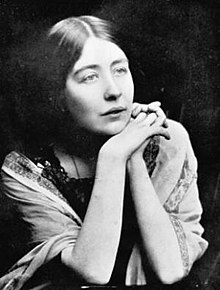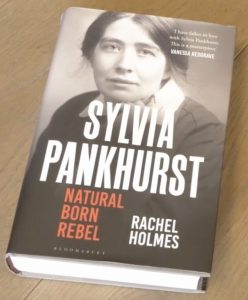History loves nothing more than a beautiful heroine battling for a just cause. For the past 100 years, Emmeline and Christabel Pankhurst have been fixed in the collective mind as glamorous symbols of the protracted struggle for votes for women. In contrast, Sylvia, the second daughter of this remarkable family, remains, according to Rachel Holmes, “one of the greatest unsung political figures of the 20th century” – a marked failure of public recognition that Holmes hopes to correct in this exhaustively researched and deeply sympathetic study of a unique life.
It is not hard to see why it has taken Sylvia so long to emerge from the shadow of her mother and sister. There was nothing fashionable about her; friend and foe alike commented on her inattention to matters of appearance (she thought lipstick an abomination). And, while Sylvia arguably gave as much, if not more, to the fight for women’s suffrage as her mother and sister, once that struggle was finished, if not completely won (full adult female suffrage was not granted in the UK until 1928), she never stopped resisting authority and fighting unpopular battles. While Emmeline and Christabel became supporters of the First World War and empire loyalists, Sylvia remained a socialist and a fierce opponent of colonialism, and the encroaching threat of fascism.
As the subtitle of this volume suggests, the tenor and tenacity of Sylvia’s public life might have been foreseen. Born in 1882, the second daughter of the radical barrister Richard Pankhurst and the fiery, implacable Emmeline, her early years were spent in an intensely political household, first in Manchester, then in London and then back in Manchester after the collapse of Emmeline’s ill-fated and poorly managed “art furniture” shop in Euston: a kind of utopian, feminine forerunner of Habitat. The Pankhurst home was filled with radical and revolutionary figures of the time, such as the Labour giant Keir Hardie, the Russian anarcho-communist Peter Kropotkin and the Indian nationalist leader Dadabhai Naoroji, the first Asian member of the House of Commons. (Tellingly, Holmes notes, Christabel later “edited out her family’s intimate friendships with revolutionaries and radicals”.)

To modern eyes, elements of the Pankhurst children’s upbringing seem unduly harsh. There were regular battles with both parents over food, and Sylvia was sometimes tied to the bedpost all day for refusing to take cod-liver oil; the introspective, dreamy young girl “could not curb her will to resist”. Yet Sylvia clearly adored her mother and father; she never stopped trying to win the affection and approval of Emmeline, who favoured the older, prettier Christabel and requested that she be buried between her two sons, both of whom died at a young age. But it was the example of her father, who died when Sylvia was 16, that really drove her: his “beseeching adjuration” that “if you do not grow up to help other people, you will not have been worth the upbringing”. There was thus bred in all the children “a sense of destiny, and of duty to be servants to the commonweal”.
That Richard Pankhurst’s favourite watch words were “drudge and drill” surely contributed to the first conflict of Sylvia’s adult life. A talented painter, she won scholarships to both the prestigious Manchester School of Art and later the Royal College of Art, where she clashed with the principal over what Holmes calls the college’s “institutional sexism”. As a young woman, she created some of the most striking artefacts and designs of the suffragette movement. But, increasingly torn between political duty and her artistic longings, by her late twenties she had become fully absorbed in the suffrage campaign.
This portion of the story is well known: the formation of the Women’s Social and Political Union (WSPU) in 1903, its growing militancy in the pre-war years, the imprisonment of activists, and the horrors of internment, including force-feeding: in Sylvia’s case a prolonged and repeated ordeal from which her digestive system never fully recovered. In 1912 Sylvia, reluctant to attack the Labour Party and as much concerned with conditions for the working class as votes for women, finally broke with the increasingly autocratic and separatist WSPU, and relocated to the East End. Here, she set up a number of practical projects to ease the burdens of the lives of working-class women, including a nursery, a toy factory and a cost-price restaurant.
Holmes perceptively grasps the many layers, and personal agonies, at work in ideological rifts within prominent political families. In 1912 Christabel, directing the militant campaign from Paris, where she lived a life of relative serenity and luxury, dashing off campaigning articles between rounds of shopping and sightseeing, sent Sylvia a telegram “containing a request to burn down Nottingham Castle”. Not your everyday sibling communication, but not a particularly astute tactical move either.
Mother and sister repeatedly denounced Sylvia in the press, and Emmeline publicly repudiated her, on account of her pacifism, in 1916. When, in 1927, the unmarried 45-year-old Sylvia gave birth to her first and only child, Emmeline cut all ties.
Holmes also brings to the fore several less well known aspects of Sylvia’s life, such as her relationship with Keir Hardie, the key figure in the formation of the Labour Party and its leader from 1906 to 1908, and the person to whom Sylvia turned for emotional and political support. Holmes confirms that the two were lovers while, refreshingly for a biographer, treading tenderly around the details of their long intimacy. Hardie emerges as a conflicted hero: a consistent supporter of women’s suffrage in the face of much Labour prejudice and indifference towards the cause, while on a personal level torn between dutiful devotion to his wife, Lillie, and his longing for more varied, and much younger, female companionship.
We also learn a great deal more about Sylvia’s socialism, an unbending commitment both passionate and pragmatic. Greatly impressed by the “soviet” model of the 1917 Bolshevik Revolution, Sylvia was soon involved in direct conflict with Lenin (that upper-middle-class confidence usually took her straight to the top). Lenin demanded British communist participation in parliament while Sylvia, by now thoroughly disillusioned with Labour, argued that the revolutionary left could “best wean the masses from faith in bourgeois parliamentarianism by refusing to participate in it”.
Keen to put her case to Lenin in person, but refused a visa by the British government, Sylvia travelled to Russia, via Scandinavia, under an alias, spending “hours of misery” in icy seas in an old, unpainted fishing smack. After a debate in the Kremlin with Lenin – a man whom she found “more wholly alive than other people” – the Russian leader paid her the backhanded compliment of immortalising her position in his famous pamphlet of 1920, “Left-Wing Communism: An Infantile Disorder”.
Those close to Sylvia could weary of her constant battling. Her old friend George Bernard Shaw claimed there were only two opinions about Sylvia: “miraculous” or “unbearable”. Soon after her release from a six-month prison sentence for publishing an article in support of a naval mutiny, Shaw prescribed “a spell of total abstinence from Weltverbesserungswahn (the illusion that the world could be better)”. Yet only a decade later, Shaw was anointing her “a modern day Joan of Arc”, suggesting that if the public wanted to know “what women can feel when they have the whole power of society marshalled against them, and they have to fight it”, they need only look to Sylvia.
The second half of Pankhurst’s life is little known but of arguably greater political significance than the first. By now in a happy relationship with the Italian anarchist Silvio Corio, the father of her son, she became Britain’s “leading, and loudest, anti-fascist”, the most vocal critic of Italy’s brutal subjugation of Ethiopia and a persistent bane of the British establishment. Churchill ordered the “besieged Foreign Office” to create a special file called “How to answer letters from Miss Sylvia Pankhurst”, while civil servants regularly declared her a “crashing bore” and “a horrid old harridan [who] should be choked to death with her own pamphlets”.
Soon after Corio died in 1954, Pankhurst moved, with her son Richard and daughter-in-law Rita, to Ethiopia, where she continued to work furiously, travelling the country on “constant journalism safaris” or busy with practical projects, until her death in 1960. Radical lives so often end in crushing failure or personal tragedy, but Pankhurst died a cherished mother and honoured citizen of Ethiopia: she was the first foreigner to be given a full state funeral.
Pankhurst’s long involvement in anti-colonialist and anti-racist struggles gives her life and work a renewed relevance. She has found the ideal chronicler in Holmes, who meticulously records, and fiercely respects, the activist life – the fatiguing rounds of political meetings, article writing, speech making, touring, lobbying, arrests and imprisonment – while always lucidly illuminating the broader context of each historical period, campaign or political ally.
At the same time, Holmes gives us a rounded picture of Pankhurst the woman: chaotic in her domestic life but devoted to those few whom she truly loved, unrelenting in her public life, welcoming of strangers but occasionally ideologically inconsistent, as in her apparent blindness to the luxury of the court of her ally Emperor Haile Selassie.
What final sense can we make of this exceptional life? Sylvia’s younger sister Adela acutely observed that “in Sylvia’s eyes, to cease to be a socialist, if one had ever been one, is a moral crime”.
Pankhurst’s refusal ever to stop agitating might plausibly be interpreted as her attempt never to be judged guilty on such a charge (or, on a more unconscious level, never to let down her father).
For Holmes, Pankhurst is a heroine: a seminal figure in a long line of formidable socialist feminists, including Holmes’s last biographical subject, Eleanor Marx: courageous women who did not cease to challenge authority, consistently unsettled established prejudices, and fought for fairer social and economic arrangements. When she was 13, Sylvia met Eleanor, who made a big impression on the idealistic teenager.
“Miraculous” or “unbearable”: either way, this impressive and unabashedly partisan biography shows that we should all be grateful to this doughty, irrepressible woman who battled so hard and sacrificed so much to make the world a tangibly better place.
Sylvia Pankhurst: Natural Born Rebel Rachel Holmes Bloomsbury, 976pp, £35


Melissa Benn writes for the Guardian and other publications on social issues, particularly education. She is the author of several books of non-fiction and two novels, including One of Us (2008), and reviews books for the New Statesman.
